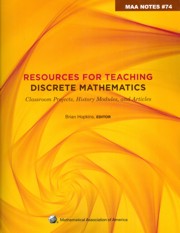Book contents
- Frontmatter
- Introduction
- Dedication
- Contents
- I Classroom-tested Projects
- The Game of “Take Away”
- Pile Splitting Problem: Introducing Strong Induction
- Generalizing Pascal: The Euler Triangles
- Coloring and Counting Rectangles on the Board
- Fun and Games with Squares and Planes
- Exploring Recursion with the Josephus Problem: (Or how to play “One Potato, Two Potato” for keeps)
- Using Trains to Model Recurrence Relations
- Codon Classes
- How to change coins, M&M's, or chicken nuggets: The linear Diophantine problem of Frobenius
- Calculator Activities for a Discrete Mathematics Course
- Bulgarian solitaire
- Can you make the geodesic dome?
- Exploring Polyhedra and Discovering Euler's Formula
- Further Explorations with the Towers of Hanoi
- The Two Color Theorem
- Counting Perfect Matchings and Benzenoids
- Exploring Data Compression via Binary Trees
- A Problem in Typography
- Graph Complexity
- II Historical Projects in Discrete Mathematics and Computer Science
- III Articles Extending Discrete Mathematics Content
- IV Articles on Discrete Mathematics Pedagogy
- About the Editor
Pile Splitting Problem: Introducing Strong Induction
from I - Classroom-tested Projects
- Frontmatter
- Introduction
- Dedication
- Contents
- I Classroom-tested Projects
- The Game of “Take Away”
- Pile Splitting Problem: Introducing Strong Induction
- Generalizing Pascal: The Euler Triangles
- Coloring and Counting Rectangles on the Board
- Fun and Games with Squares and Planes
- Exploring Recursion with the Josephus Problem: (Or how to play “One Potato, Two Potato” for keeps)
- Using Trains to Model Recurrence Relations
- Codon Classes
- How to change coins, M&M's, or chicken nuggets: The linear Diophantine problem of Frobenius
- Calculator Activities for a Discrete Mathematics Course
- Bulgarian solitaire
- Can you make the geodesic dome?
- Exploring Polyhedra and Discovering Euler's Formula
- Further Explorations with the Towers of Hanoi
- The Two Color Theorem
- Counting Perfect Matchings and Benzenoids
- Exploring Data Compression via Binary Trees
- A Problem in Typography
- Graph Complexity
- II Historical Projects in Discrete Mathematics and Computer Science
- III Articles Extending Discrete Mathematics Content
- IV Articles on Discrete Mathematics Pedagogy
- About the Editor
Summary
Summary
In many textbooks in discrete mathematics there are numerous examples for teaching the Weak Form of the Principle of Mathematical Induction, but relatively few elementary problems for applying the Strong Form. What follows is a nice example to draw on when introducing the strong form. It can be presented as a classic puzzle, it has a number of variants and it is inherently recursive.
By introducing the problem (Pile Splitting) as a puzzle, the instructor can engage the students in the process of finding a general solution. She can, then, raise the question as to how they can demonstrate that their conjecture is correct, and, thereby, motivate the need for strong induction. After an induction argument has been presented (the Worksheet includes one such proof), variants of the puzzle can be assigned for the students to work on in class or as a homework assignment.
Notes for the instructor
To give students practice in making conjectures about the solution to the puzzle, they should be asked to solve it themselves. One hands-on approach that works well is to provide each student with a sufficient number of beads or pennies for her to actively play the game enough times with different values of n so as to see a pattern emerge. Those students who correctly conjecture the general solution can assist the others. One way of reaching the conjecture is explained on the Solutions page.
Information
- Type
- Chapter
- Information
- Resources for Teaching Discrete MathematicsClassroom Projects, History Modules, and Articles, pp. 7 - 10Publisher: Mathematical Association of AmericaPrint publication year: 2009
